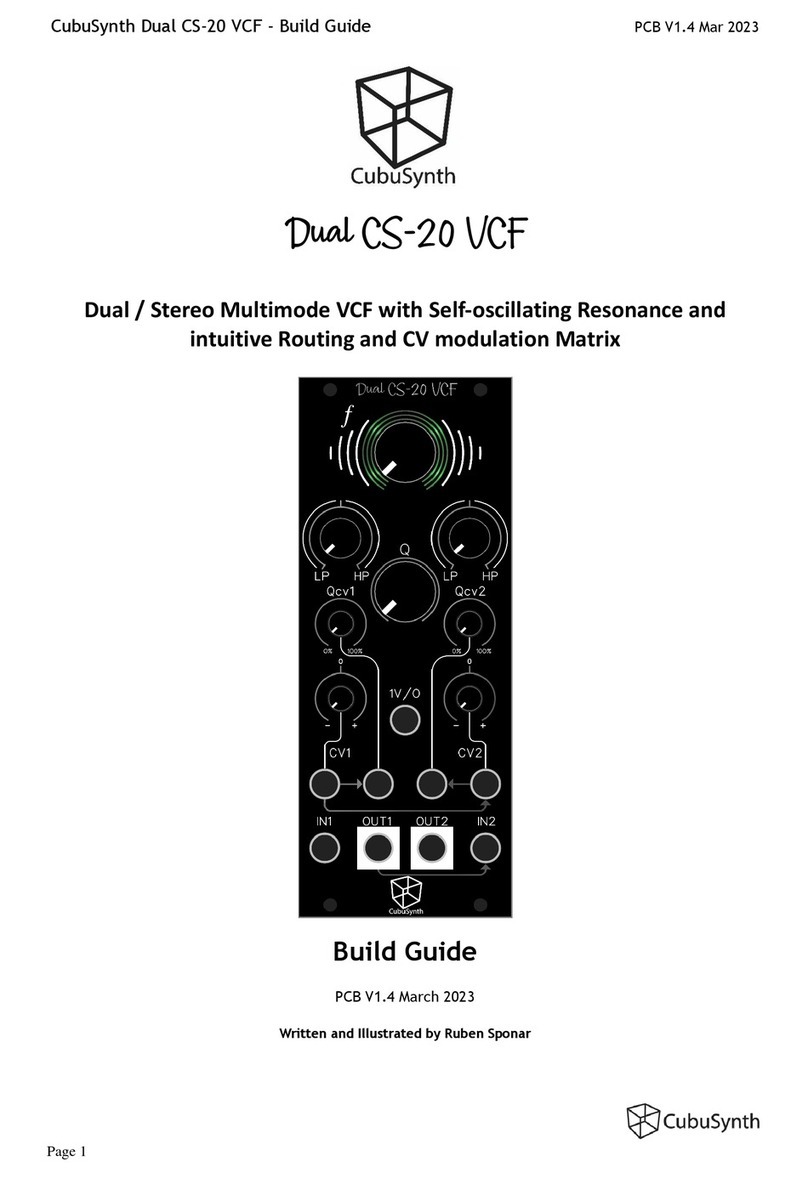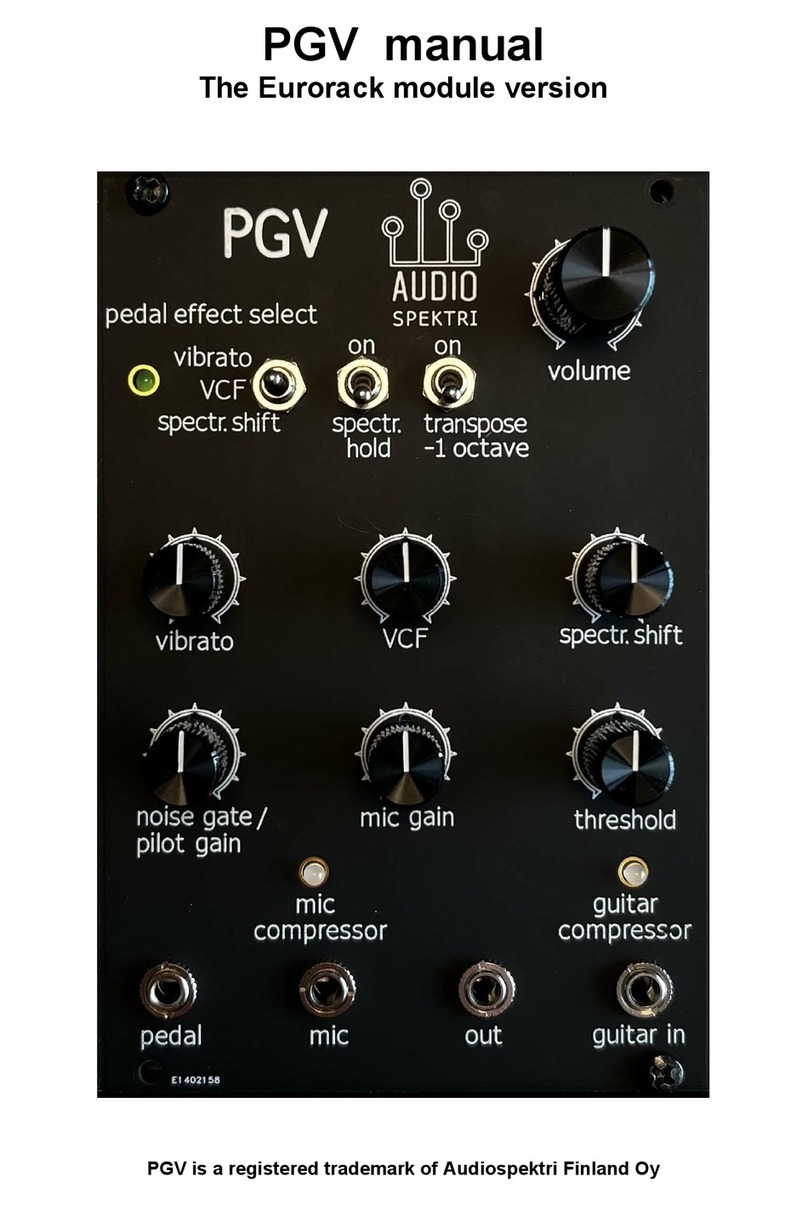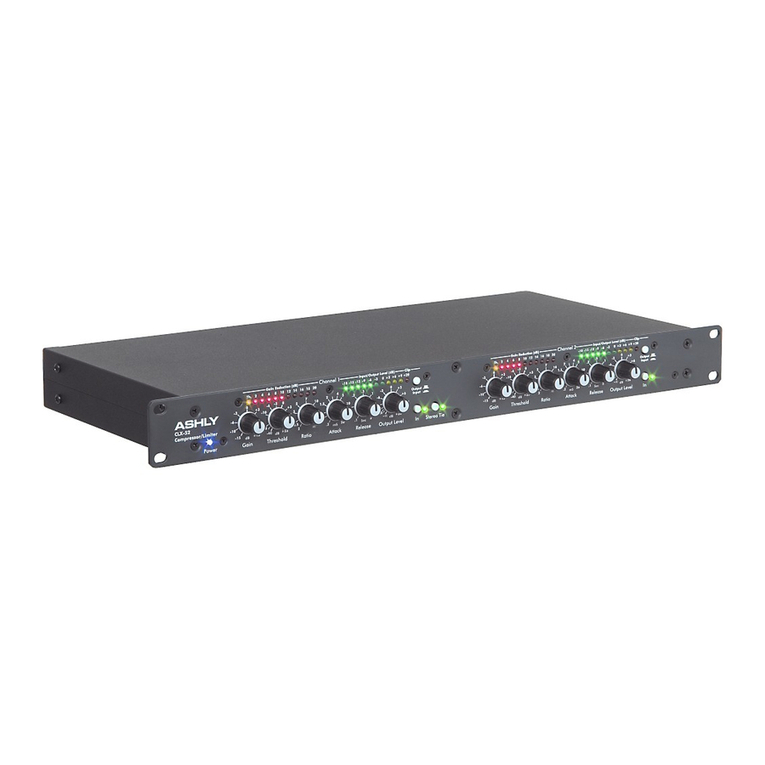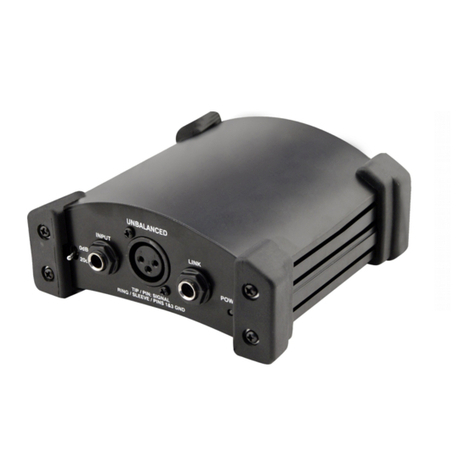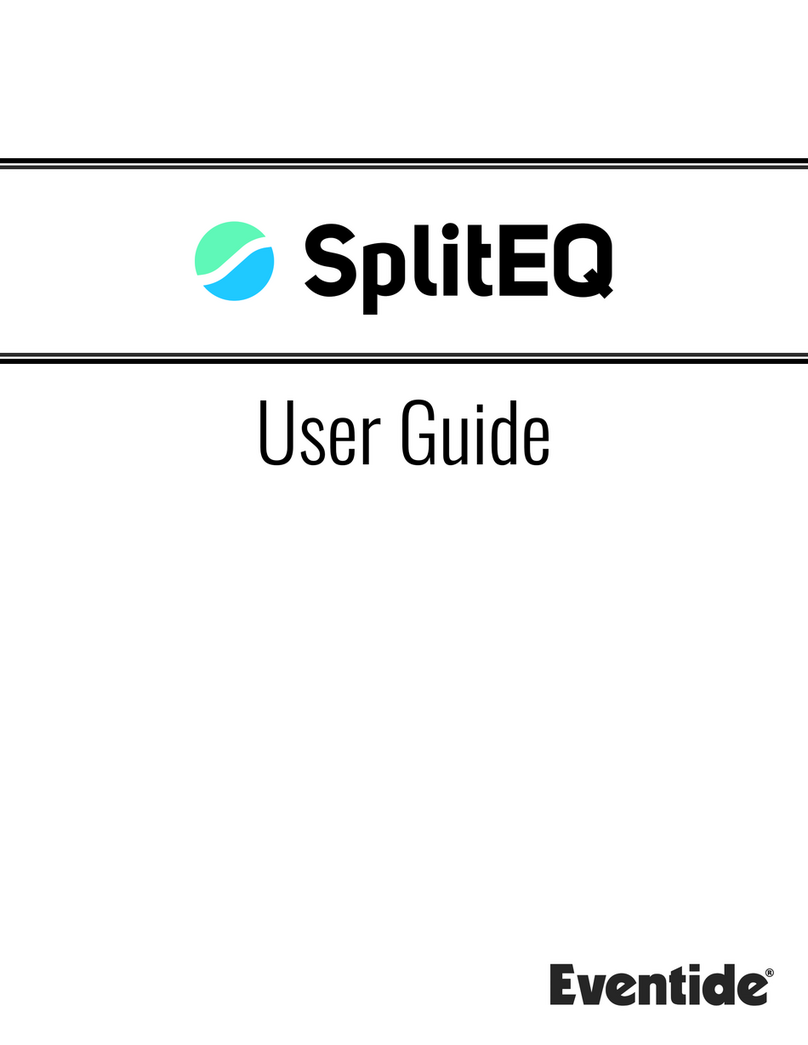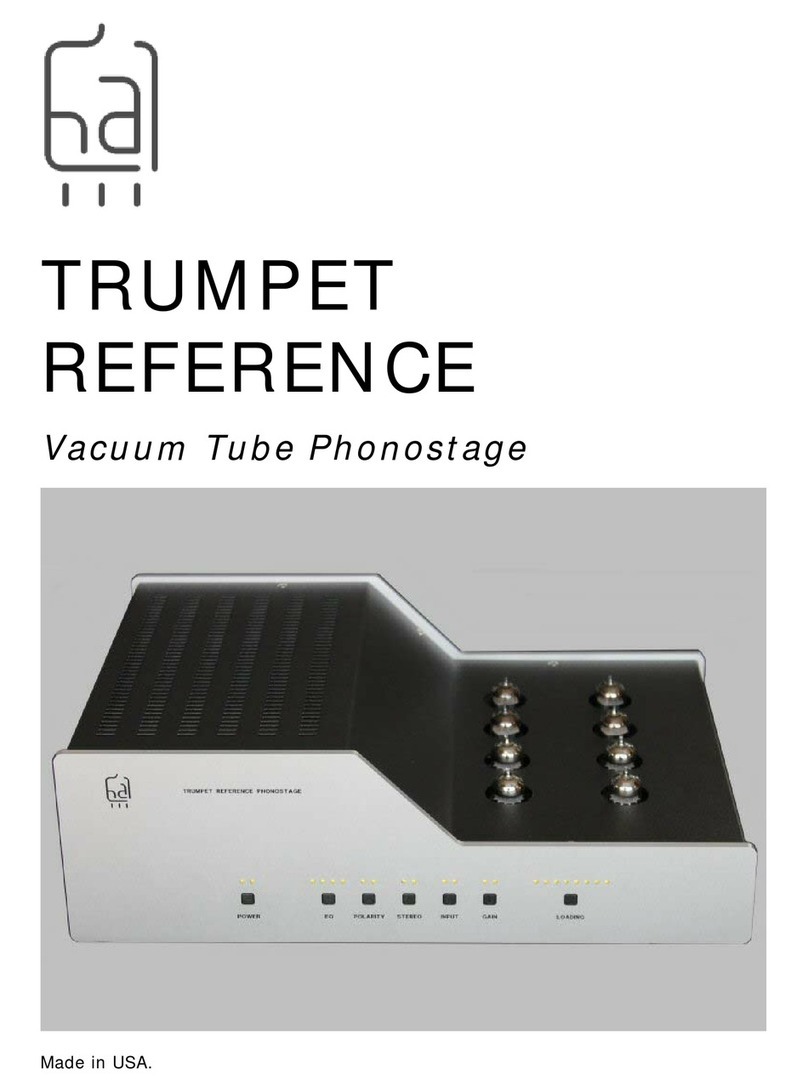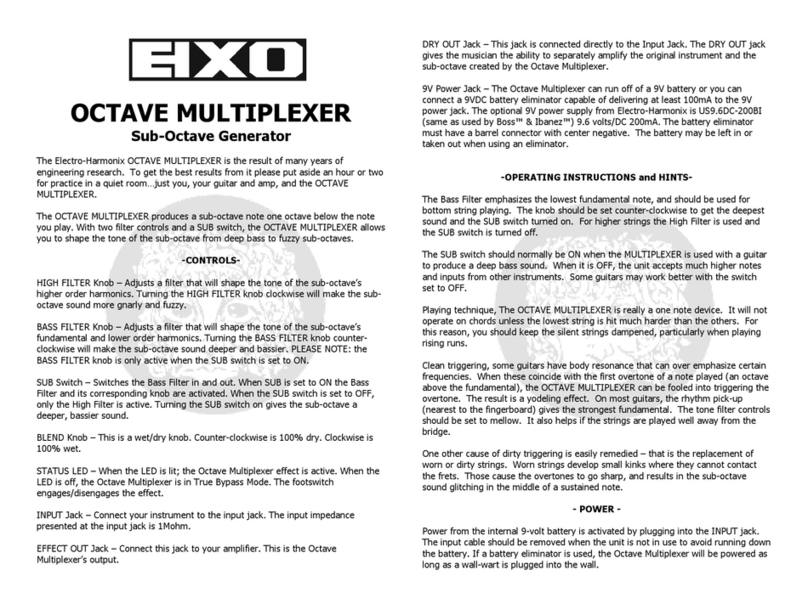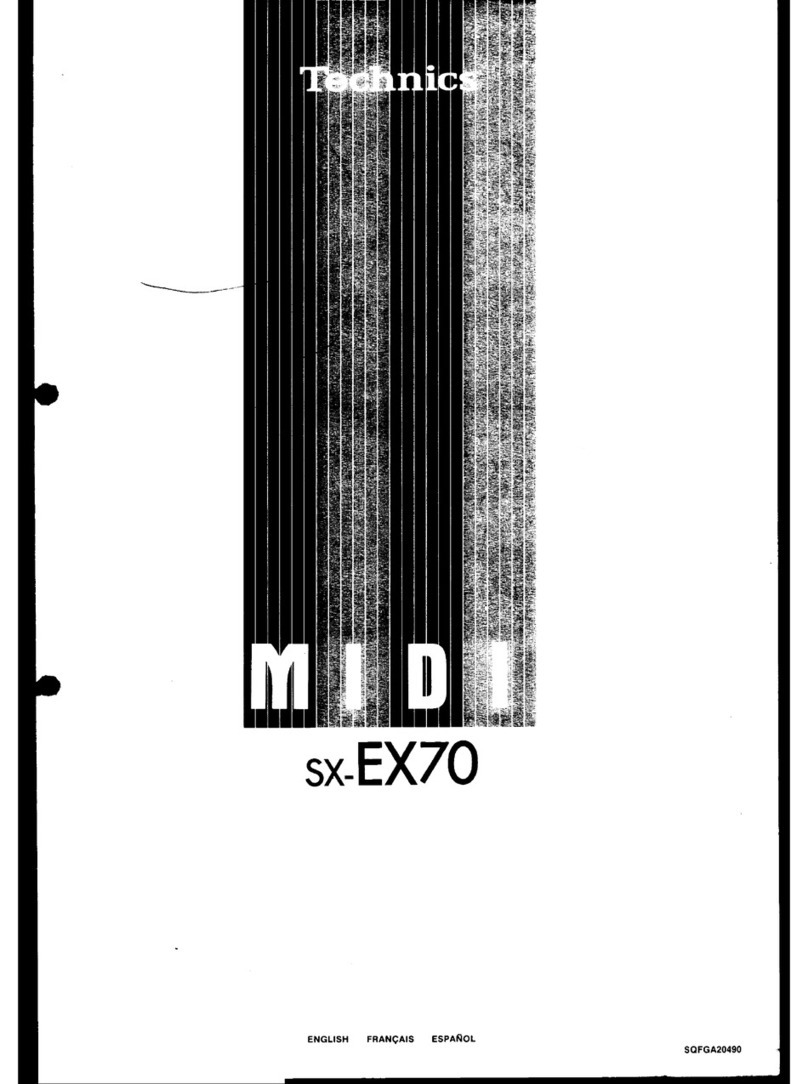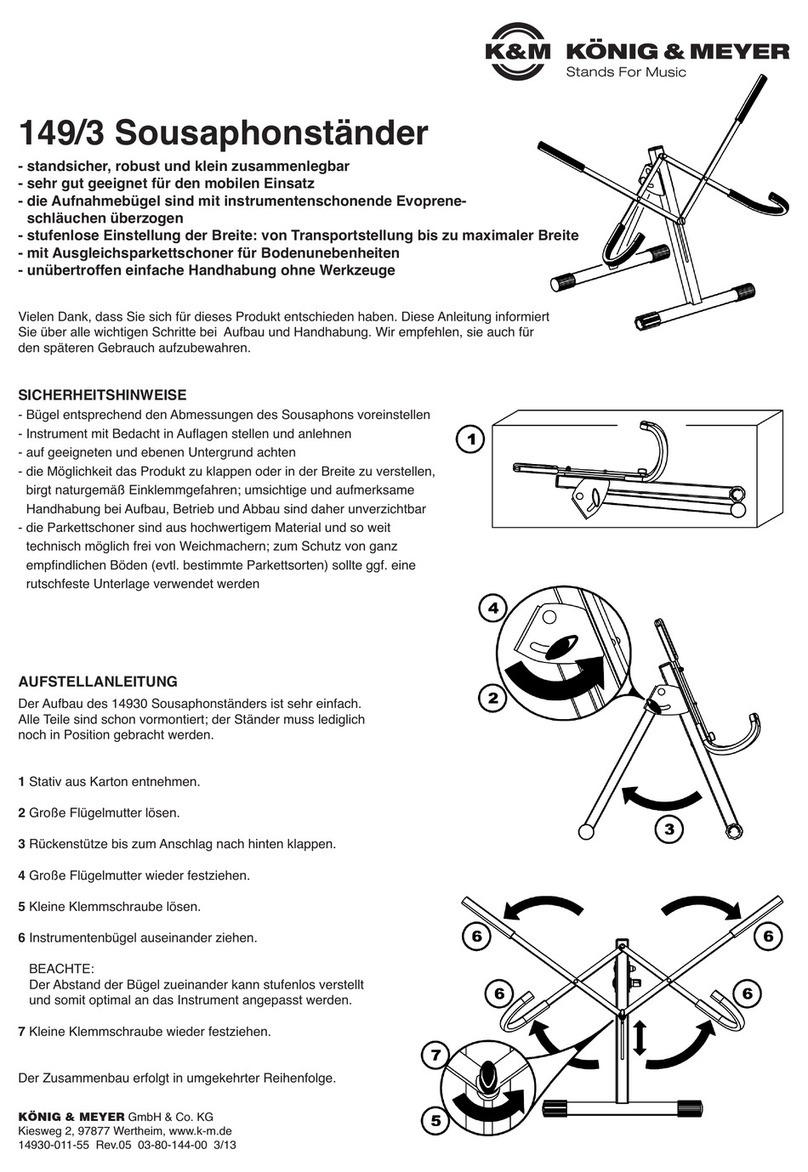StewMac 1933 Pre-war OM-28 User manual

1933 Pre-war OM-28
Acoustic Guitar Kit
#WRM3H2 Assembly Instructions
stewmac.com
tools + ideas for guitarmaking
StewMac


stewmac.com
Getting started
Welcome to guitar building! .....................5
Recommended tools and supplies ...............6
Kit parts list .....................................7
Side Assembly
Assembling the sides ...........................8
Making a body mold ............................9
Installing the side reinforcing ribbon ............10
Installing kerfed linings .........................10
Squaring the neck block and tailblock ...........10
Leveling the kerfed linings . . . . . . . . . . . . . . . . . . . . . .11
Soundboard bracing and tting
Installing the soundhole rosette .................12
Installing the soundboard bracing ..............13
Bridge and shoulder brace clamping cauls .......15
Fitting the soundboard to the sides .............16
Installing the soundboard .......................18
Back bracing and tting
Installing the back bracing ......................19
Fitting the back to the sides .....................20
Installing the back ..............................20
Routing and binding
Trimming the top and back overhang ...........21
Routing for the plastic body bindings ...........21
Installing the end trim ..........................23
Installing the bindings ..........................23
Opening the dovetail joint ......................24
Fit and ll the truss rod channel
Fitting the truss rod .............................25
Fill the channel..................................25
Peghead shaping and drilling
Peghead overlay ................................26
Shape the peghead .............................26
Making a fretboard
Trimming the fretboard .........................27
Inlaying the fretboard ...........................27
Installing the fretboard side dots ................28
Installing the frets ..............................28
Installing the fretboard .........................29
Neck shaping and tting
Shaping the neck ...............................30
Installing the nut ...............................30
Fitting the heel cap .............................31
Understanding the neck joint ...................31
The neck heel sets the neck angle ...............32
Fitting the neck to the body .....................32
Neck adjustment: side-to-side ...................33
Neck adjustment: tilt the neck back .............33
Neck adjustment: tilt the neck up ...............34
Tightening the dovetail joint ....................34
Installing the last frets ..........................34
Finishing
Introduction to nishing and materials ..........35
Sanding the body ..............................35
Filling the fret ends .............................36
Sanding the neck ...............................36
Spray handles and hangers .....................36
Masking the neck and body .....................36
Staining ........................................37
Applying a washcoat to seal the wood ..........37
Filling the wood grain pores ....................37
Lacquer spraying schedule ......................37
Sanding and rubbing-out the nish .............38
Final assembly and setup
Prepare for neck installation ....................39
Install the neck .................................39
Prepare for bridge installation ...................39
Installing the bridge ............................40
Fitting the bridge pins...........................40
Fitting the bridge saddle ........................41
Installing the tuning machines...................41
Seating the strings ..............................42
Understanding neck relief ......................42
Adjusting string action: nut slots & saddle height 42
Leveling the frets ...............................43
Installing the pickguard .........................44
Installing the endpin and strap button ..........44
CONGRATULATIONS! ............................44
Table of contents
3


stewmac.com
And nally, while you’re probably excited to get started, you
need to take a little time to acclimate your kit. Thin pieces
of wood (like the ones you nd in acoustic guitars) are ex-
tremely sensitive to changes in humidity and temperature.
The ideal building environment is 70-80° Fahrenheit (21-26°
Celsius), with a controlled relative humidity of 45-50%. The
woods in your kit should be laid out and allowed to acclimate
in your shop for one week before you start your build. Flip
the wood daily to neutralize excessive warping.
Depending upon your location and the season, you may
need to humidify or dehumidify your shop to maintain the
desired relative humidity. It is highly advisable to purchase
a decent quality thermometer/hygrometer to monitor your
shop’s climate. If you’re unable to control the relative humid-
ity in your shop, we discourage building the guitar during
the transition from dry to wet seasons, or vise versa.
Radical changes in humidity, especially during season
changes, can cause warping, splitting and other serious
complications. You’re going to put a lot of love into this build
and this small preventive eort is well worth the extra eort.
And nally, be safe when using tools, glues, and chemi-
cals. Wear eye protection and gloves when needed, and
always use proper ventilation.
Congratulations. We wish you all the best on your build, and
remember, if you get stuck or have any questions along the
way call us. We’re here to help.
You’ve probably dreamed about owning a pre-war herring-
bone OM. Most of us have. Many guitarists consider these
instruments to be the greatest acoustic guitars ever built.
However, the originals are VERY expensive, and VERY hard to
nd. Those two facts alone make these guitars inaccessible
to most musicians.
However, while you might not be able to BUY one, you can
BUILD one (or at least a very accurate replica). We’ve meticu-
lously reproduced an original pre-war 1933 OM-28, down to
the smallest detail!
Not only does the StewMac Icon Guitar Kit capture the cor-
rect period LOOK of the original, but it also faithfully repro-
duces the “bones” of the instrument, so you can get as close
as possible to that authentic, revered tone.
When you’re done with this project you’ll have a true heir-
loom that you’ll enjoy for years and proudly pass down to
future generations.
We designed this kit for the small shop builder with a mod-
est tool budget. With the exception of a few specialty guitar
making tools, you probably already own most of the items
you’ll need to build this guitar.
A few notes before you get started:
Please read all of these instructions before starting your
build. The instructions and plans were developed specically
for this kit. The video that’s included covers the essential
steps for building an acoustic guitar, but it was developed
for our standard acoustic guitar kits, not this pre-war Icon
kit. Therefore, you should always reference these instruc-
tions and the included blueprint for specic details while
building your Icon.
Speaking of the blueprint; modern printing technology
doesn’t always faithfully reproduce measurements down
to the tolerances we need in guitar building. As a result,
always refer to the printed measurements versus measuring
the template directly. As small as these dierences are, they
can make a dierence.
Getting started
Welcome to guitar building!
5

stewmac.com
Recommended tools and supplies
StewMac has easy-to-order
sets of tools that kit builders
nd most useful.
Search "acoustic kit tools” at
stewmac.com
Supplies
3/4" plywood workboard 24" x 20"
Bind-ALL Binding Glue #1976
Titebond Glue #0620
Fish Glue #0702
Super Glue (#0010 thin and #0020 medium)
Double-stick tape #1689
Low tack protective tape #1682
Masking/binding tape (high tack) #0584
Rubber binding bands #1256 (option to using binding tape)
Sandpaper (80, 100, 150 and 220-grit)
Wax paper
White pencil
Felt-tip marker
Capo #4571
Clean cotton glove
Finishing materials (for aerosol nitrocellulose
lacquer nish)
Guitar Finishing Step-By-Step book #5095
Fre-Cut® sandpaper 150, 220, 320, 600, 800, and 1200-grit
at least 2 sheets
of each grit (included in Finishing
Paper Sampler Package #5562)
ColorTone Concentrated Liquid Stain (tobacco brown #5034,
red mahogany #5032)
ColorTone Grain ller
ColorTone Clear Gloss aerosol nitrocellulose lacquer (6) #3881
Blush Eraser #1313
StewMac Polishing Compound medium #1202 and ne #1203
StewMac Swirl Remover #1204 (optional)
Foam Polishing Pads (2 or 3) #3414 and electric hand drill
Naphtha solvent #0775
Paint stripper
Masking supplies: brown paper, masking tape, cardboard
and rubber balloon (or newspaper) for soundhole
The following tools and supplies are recommended to as-
semble your kit. Though all of these tools aren’t necessary
to build your kit, they make many assembly steps easier
and more professional. Where applicable, item numbers for
ordering from StewMac are included.
For binding installation, you have a couple of dierent
options to choose from depending on the tools you already
own. If you plan on using a laminate trimmer or router for
binding channels, we suggest our Binding Router Bit (#1298-
B) and bearings (#1298-060, 1298-200). It is our preferred
method. If you plan on routing your binding channels with
a Dremel tool, our Precision Router Set (#5263) ships with
everything you will need.
Tools
Electric hand drill
Coping saw
Center punch or awl
Glue brushes #4167
6" Steel rule #4894
1/2" Chisel #1623
File set #0842
Small rasp #4154
Fret Leveler #0862
Dressing stick #1939
Fret cutter #0619
Deadblow fret hammer #1296
18" Straightedge #3850
.020" gauged saw #3572
Scraper blade #0654
4mm Allen wrench #6113
Nut-slotting les: 0.016" width (#0827)
and 0.035" width (#0832)
1/4"-diameter bit #4850
Bridge pin reamer #3227
Fret dressing le, medium # 1602
Radius-sanding block, 16" radius #0413
Small cam clamps (at least 2) #3724
Large cam clamp (2) #3725
Spool clamps (24) #3715
Clothes pins (50)
Medium bar-style clamp (2) #3714
X-Acto knife
Small carpenter’s square
Feeler gauges #1811
6

stewmac.com
1 Back brace set (9 pieces)
2Waverly Tuning Machines
3Mahogany neck, dovetail
4 Hot Rod truss rod
5Soundboard brace set (11 pieces)
*Wide, at brace not used.
See page 14 for details
6 Shim stock
7Rosewood bent sides
8Rosewood back
9Red spruce soundboard
10 Fretwire (3)
11 Pickguard
12 Bridge
13 Neck block, dovetail
14 Tailblock
15 Slotted fretboard
16 Fret markers (7)
17 Puring for rosette
18 Herringbone puring (2)
19 Puring strips (2)
20 Binding (4)
21 Bridge pins (6) and endpin
22 Strap button
23 White side dot material
24 Bone saddle
25 Bone nut
26 Rosewood peghead
overlay veneer
27 Maple bridge plate stock
28 End trim, heel cap
29 Reinforcing ribbon
30 Tail block strip
31 Cheesecloth
32 Kerfed lining (8)
33 Cardboard body form (2)
34 Building an Acoustic Guitar Kit
DVD
35 Blueprint
36 Bracing pattern
Not pictured: this assembly
instructions book, scrap wood, and
large rubber band.
1
2
3
5
7
9
12
13
15 17
32
33
35
36
27
29
28
16
21
22
30
23
24 25
26
14
18
31
19
20
34
10
11
8
6
4
Kit parts list
*
7

stewmac.com
Each bent guitar side has been formed from a tapered piece
of wood. One of the longer edges is straight (the guitar top)
and the other is slightly curved (the back). Place the sides,
straight edges down, on the workboard and butt the ends
together. The sides shouldn’t rock on the workboard surface.
Pencil accurately measured centerlines on the neck block
and the tailblock, and align these marks against the inner
seams of the adjoining guitar sides. The open end of the
neck block must face downward against the workboard,
and both blocks must be ush with the sides at the top and
bottom.
Dry-clamp the two blocks to the sides, place a piece of wood
across the waist, and rest a weight (a couple of bricks worked
for us) on the piece of wood (pictured) to keep the sides
at against the cardboard. Now readjust the neck block and
tailblock while the sides are weighted down.
KIT TIP: Dry clamping
It’s important to try tting and clamping the kit
pieces before you use glue. Practice a “dry run” to
make sure you have all the clamps and cauls needed
before glue is applied. We found that using a little
brush (like our Glue Brush) helps to apply the glue
evenly on the surface.
The back side of the neck block has a fairly steep 5° angle to
match the arch of the back. Viewed from the side, in cross-
section, both ends of the neck block are ush where they
meet the sides, but the 5° side will be higher than the sides
as it tapers up toward the interior of the guitar.
The side of the neck block that touches the guitar sides is
curved. A clamping caul with matching curvature (illus-
trated) should be prepared from scrap wood and placed
against the outer side seam. The same caul will t both the
neck block and tailblock areas.
KIT TIP: Cauls
You’ll need scrap wood to make cauls that will be
used throughout assembly. Cauls are used to ap-
ply uniform pressure while the glue dries, and to
protect the guitar’s surface from the clamps.
Remove the clamps and, one at a time, apply Titebond glue
to the inner block surfaces. Reclamp using four clamps per
block. Wipe o the excess glue with a damp cloth and let
the assembly dry overnight before unclamping. Use waxed
paper to prevent the wooden parts from being glued to the
cardboard surface.
After unclamping the neck block and tail block, draw a
center line on the maple tailblock reinforcement strip, and
also on the top and bottom of the tailblock. On the side of
the tailblock that contacts the back, measure down 3/16"
make a mark (this is for clearance for the back center strip).
Apply glue to the maple reinforcement strip and place the
centerline on the marks on the tailblock and to the edge of
the 3/16" mark.
Side Assembly
Assembling the sides
Clamping caul with
curved face
Use
waxed
paper to
protect
guitar
sides
Use four
clamps
Neck
block
5° taper for back
8

stewmac.com
Using the two heavy cardboard body forms (supplied with
the kit) create a guitarmaking form which supports the body
during the early stages of assembly.
First, place two scraps of 3/4" plywood onto the work surface
inside the guitar. This will lift the cardboard form up to make
room for the kerfed linings which will be installed later. Lay
the rst cardboard piece onto the 3/4" plywood inside the
guitar body.
Next, glue a 2" thick block of scrap wood onto the cardboard,
centered about 4" from the smaller end of the guitar mold.
Then glue a second 2-1/2" piece of scrap wood, centered
about 4" from the bottom (larger end) of the guitar mold.
Glue the second piece of cardboard onto them. Now the
two cardboard forms are fastened together with blocks of
wood between them, creating a three-dimensional form for
supporting the guitar sides.
Make a U-shaped waist clamp from 3/4"-thick plywood, using
the waist clamp measurements (illustrated). The purpose
of the waist clamp is to hold the guitar’s waist tight to the
inner cardboard mold, maintaining a constant shape until
the back is glued on.
Use a le to round the two inner edges of the waist clamp
to remove edges and protect the guitar sides.
To start out, install the waist clamp from the back side of
the guitar. (Later, after the top is installed, you’ll switch the
waist clamp to the top side) When sliding the waist clamp
on, hold the guitar sides tight against the cardboard form
to keep from cracking the sides. If the t is too tight, remove
small amounts from each side of the U-shape until the waist
clamp slides snugly onto the waist (but not so snug that it’s
hard to remove).
Making a body mold
Rounded
edge
Waist
clamp
2" block
2-1/2"
block
Corrugated
cardboard
Workboard
3/4"
scrap
9-7/32"
6"
2"
2"
13-7/32"
Waist Clamp
Made from 3/4"-thick plywood
9

stewmac.com
Eight kerfed (notched) wooden lining strips are supplied for
reinforcing the glue joints between the soundboard, sides
and back. Refer to the blueprint; dry-clamp (no glue) the
linings to the top edge of the side assembly using ordinary
spring-tension clothespins (pictured).
Each side of the guitar requires two strips, which should
be accurately trimmed where they meet the body blocks.
Use at least four or ve dozen clothespins. The top (gluing)
surface of the linings should extend 1/32" above the edge
of the guitar’s sides, on both the top and back sides.
The linings are left slightly proud so that you’ll have a little
wood to sand o until the linings comes perfectly ush with
the top edge of the sides, and to make up for any possible
misalignment during glue-up.
Disassemble, trim the linings, glue them into place with
Installing kerfed linings
Squaring the neck block and tailblock
Although they work quite well, the waist clamp and card-
board inner body mold still allow some movement. Handle
the rim assembly carefully, especially until the top and back
are glued on and the assembly becomes more rigid. Lay the
rim assembly topside-down on the plywood work surface,
weight it down again, and use a square at each end to see
if the neck block and tailblock are square to the plywood
surface. If either end is slightly out of square, use a thin ta-
pered wedge pressed between the cardboard inner body
mold and either the neck block or tailblock as needed, to
force the blocks and sides into square (pictured). Having
the sides properly squared up at this stage is important.
The blueprint included with your kit illustrates the positions
of vintage-style cloth side reinforcing ribbon. Transfer the
centerlines of the reinforcement strips from the blueprint to
the inner sides of your kit. Measure, mark and cut eight strips
for each side from the ribbon supplied with your kit. Each
strip should go from the back edge of the sides to the top
edge so the kerfed lining will be later glued over top of the
ribbon (pictured). Mark the centerline on the ribbon on the
ends of the ribbon with a marker (only on the area that will
be covered by the kerfed linings. With a glue brush, apply a
thin lm of sh glue (you don’t want any glue squeeze out)
on the back side of the ribbon and place it on the transferred
centerline. Use a piece of wax paper on top of the ribbon
to smooth it out and apply pressure. You shouldn’t need
any type of clamping but if they try to curl up, use strips of
binding tape to hold them at then carefully peel the tape
o after 24 hours.
Installing the side reinforcing ribbon
Titebond, check the 1/32" clearance and reclamp. Let the
glue dry for 4 hours. Install the lining strips on the back edge
of the side assembly in the same manner.
10

stewmac.com
Prepare a “sanding board” from a straight at piece of wood
about 3-4" wide, at least 1" thick, and 24" long (illustrated).
Add a 5° wedge on one end of the sanding board. This wedge
will tip the sanding board to match the angle of the back as
you sand the kerfed linings, neck and tailblock. The wedge
should be approximately 8" long, and as wide as the sand-
ing board. At the opposite end, stick 80-grit sandpaper to
both sides of the board using adhesive backed sandpaper
or double-stick tape.
Rest the side assembly, with the straight top edge down,
on the at surface of your workbench. The front shoulders
should overhang the bench, so that the waist clamp can be
fastened to the edge of the benchtop with two wood screws.
If you’re unable to screw the waist clamp to the bench, clamp
a board ush to the bottom edge of your bench, and clamp
or screw the waist clamp to the board.
Draw a white pencil line on the edge of the guitar sides to
serve as an indicator of your sanding progress. Stop sand-
ing when the line is gone and you begin to graze the sides.
Hold the wedged end of the board against the tailblock as a
pivot point, and begin sanding the neck block and the front
shoulder area rst. Work around the sides to the tailblock,
moving the pivot point frequently, until the sandpaper
begins grazing the white pencil marks on the top edge of the
sides. It’s easy to oversand the sides and the kerfed linings,
leaving the neck block or tailblock higher than the sides,
and causing a “hump” in that area later. Keep this in mind,
and give the blocks a little extra sanding. White pencil them
several times and use a straightedge to be sure they are at.
Move the waist clamp to the back side of the rim assembly,
and refasten the clamp to the bench with the top kerfed
linings facing up. Repeat the sanding process, but this time
using the at side of the sanding board. The top kerfed lin-
ings are easier to sand than those on the back of the rim.
When your sanding reaches the white pencil line, the linings
are ready for the guitar top to be tted.
KIT TIP: Back kerfed lining
The back kerfed linings can be level-sanded AFTER
the top is glued to the sides. The rigidity added by
the glued top makes the sanding easier and more
accurate. If you choose this option, level the top ker-
fed linings rst (pictured), and sand the back linings
just before removing the cardboard inner mold.
5° wedge for
sanding back edge
Sandpaper
on both sides
Sands the kerng
at the angle
of the tapered
block
Leveling the kerfed linings
11

stewmac.com
Soundboard bracing and tting
Installing the soundhole rosette
The soundhole rosette is made up of multiple black and
white puring strips. DO NOT separate the purling strips
until you are ready to dry t and glue. The strips that make
up the rings have the ends taped together for you to keep
them in the proper order. The strips are also grouped for you
in the sets that make up the three rings.
We suggest taping the middle with a very thin tape in the
middle to make dry tting easier. Pay close attention that
the separate pieces that make up each ring do not get out
of order. Consult the diagram if you get them out of order.
The purings are longer than needed, to enable the removal
of the straightened ends on each ring left from the bend-
ing process. Note the outer rings will be hidden, but the
smallest/inner ring will be exposed. Practice the trimming
on the hidden ones rst, you want to get the exposed one
perfect. A few extra minutes of careful work here will make
a big dierence in the appearance of the nal instrument.
Glue the purings in place with Bind-ALL and press them
rmly into the channels. A at clamping caul covered in wax
paper will seat them well. After drying, scrape the purings
ush to the surface of the soundboard, using a sharp scraper
blade. Flex the scraper slightly as you work, and trim the
purings until the tool begins to pick up bits of spruce. You
can also use a at block of wood wrapped with a piece of
150-grit sandpaper.
Stewart-MacDonald's Guitar Shop Supply
Drawn by Material
Date Part No.Drawing No.
Scale
Decimal
Fractional
Angular
±
±
Tolerances
(except as noted)
±©
Todd
2019
09/26/19
ICON D-28 Kit Top Rosette Rings
.005"
ABS Plastic1:1
D91136A
.085"
.046"
.025"
.021"
.010"
.010"
.020"
.025"
.010"
.020"
.230"
Inner and Outer Rings
Center Ring
Inner and Outer Rings Center Ring
12

stewmac.com
Installing the soundboard bracing
Using the OM Forward X Bracing pattern provided (NOT
the blueprint), pencil the soundboard bracing pattern
(pictured) on the inside surface of the soundboard (cut
small holes in the pattern at the corners and intersections
of the braces, lay the pattern on the soundboard, transfer
the hole positions in pencil, and “connect the dots” on the
soundboard when the pattern is lifted away). The pattern
MUST be correctly centered along the soundboard’s center
seam, with the soundhole properly located. Note that the
soundboard and the back have been trimmed to allow
about 1/8" overhang all around. This oers a little freedom
when assembling the top and back to the rim, and will be
trimmed away later.
13

stewmac.com
Identify your soundboard braces: the two long X-braces (T-1
on the blueprint), the tall front shoulder brace (T-5), and the
tone-bars (T-2) are radiused. The four small braces (T-3) are
not radiused. The wide at brace (T-6) is not used on this
model guitar, you can discard it.
With the soundboard face down on your workboard, place
these two X-braces on the penciled lines and mark where
they cross. With a razor saw, notch the radiused T-1 braces
so they interlock. Using the rigid workboard, dry-clamp the
ends in place, at to the soundboard (pictured). Clamp
the center of the “X” down, using one or two long cam
clamps. The combination of the curved braces and the rigid
workboard will produce the proper soundboard arch (a 28-
foot radius) when the clamps are removed.
As shown in the blueprint, the ends of the T-2 tone-bars,
the four small T-3 braces, and the maple bridge plate tuck
under the X-braces. File these notches in the X-braces at a
45° angle (pictured). Using a sharp chisel, carefully shape
a matching angle on one end of these braces where they
tuck under. Reclamp the X-braces onto the soundboard and
workboard. Check the t of the tone bars in the notches.
Disassemble, apply Titebond to the braces and tone bars,
reclamp, and let the glue dry overnight. This work can be
done in stages, depending upon the number of available
clamps. Use two at clamping cauls for each pair of tone
bars, with the soundboard resting on your workboard to
keep it at at this stage (pictured). Cut the three at sound-
hole reinforcement strips (T-4) to length and glue them into
position on the soundboard.
Transfer the outline of the bridge plate from the bracing pat-
tern to the at maple bridge plate stock. Saw out the plate
and true its edges against a piece of sandpaper taped to a
at work surface. Don’t drill the bridge pin holes yet; this will
be done later. File a 45° bevel at each end of the bridge plate
and check for proper t in the X-brace notches. File o each
pointed end of the bridge plate so that it can slide forward
as it tucks under the X-braces. Prepare a wooden clamping
caul to t snugly over the installed bridge plate between
the X-braces, and glue the plate onto the soundboard with
Titebond or hide glue. The lower clamp jaws should
contact
the back of your workboard to protect the spruce soundboard.
14

stewmac.com
While the braces are accessible, prepare a bridge clamping
caul and a shoulder brace caul that will be used in the “Install-
ing the neck” and “Installing the bridge” sections. The bridge
caul (illustrated) is 7-1/2" x 1-3/4" x 3/4". It must be relieved
to contact the bridge plate and the soundboard, and have
sucient relief to clear the X-braces and the tone bars. The
easiest way to create this relief is to glue scrap corners from
the bridge plate itself onto the corners of the caul. This way,
the caul’s center portion is relieved by an amount equal to
the thickness of the bridge plate.
The shoulder brace caul is 2" x 2-5/8" x 1-1/4", with relief to
clear both shoulder braces. Use a saw and a chisel or router
to make these cauls.
Bridge and shoulder brace clamping cauls
1-3/4"
3/4"
7-1/2"
2"
1-1/4"
2-5/8"
Bridge clamping caul
These surfaces must contact the soundboard;
the notches should not contact the braces.
This surface must
be relieved to contact
the maple bridge plate.
Shoulder brace caul
1-3/4"
3/4"
7-1/2"
2"
1-1/4"
2-5/8"
Bridge clamping caul
These surfaces must contact the soundboard;
the notches should not contact the braces.
This surface must
be relieved to contact
the maple bridge plate.
Shoulder brace caul
1-3/4"
3/4"
7-1/2"
2"
1-1/4"
2-5/8"
Bridge clamping caul
These surfaces must contact the soundboard;
the notches should not contact the braces.
This surface must
be relieved to contact
the maple bridge plate.
Shoulder brace caul
Place the two supplied pieces of cheesecloth on top of
each other and cut into approximately a 1-1/2" circle. Keep
the two pieces together and apply glue to one side of the
cheesecloth, then place the cheesecloth (glue side down)
over the intersection of the X braces (pictured). Use a small
screwdriver or scrap of the wood soundhole reinforcement
to push the cheese cloth into the corners on the sides of
the X brace intersection. Let this dry overnight and trim any
protruding strings with a razor knife for a clean look.
15

stewmac.com
To t the top, the ends of the X-braces and the tall shoulder
brace must be notched into the kerfed linings. The remain-
ing smaller braces will be tapered to nothing where they
meet the lining.
KIT TIP: Tapering smaller tone bars
The blueprint shows the ends of the T-2 tone bars
notched into the kerfed lining, but we now suggest
that you taper them before they reach the lining.
The choice is yours. Tapering these braces to noth-
ing will let the top ex a little more.
For this tting, leave the side assembly clamped to the
workbench if you’re able to work around the assembly com-
fortably. You can unclamp the side assembly and the waist
clamp from the workbench if it makes tting the top easier,
but be sure to handle the assembly gently. Don’t bend or
twist the sides as you t the top.
Chisel the ends of the X-braces and tall shoulder brace down
to a thickness of .100" (pictured). Follow the pre-machined
taper of the braces as you chisel.
Fitting the soundboard to the sides
To find the guitar’s accurate length between neck and
tailblocks, rst measure 4" from the top edge of the sound-
hole, towards the neck block (illustrated). Make a pencil
mark on the centerline, on the underside of the soundboard.
Measure 19-1/4" from this mark to the tailblock end, and
make a mark. This is the body length. During gluing, these
marks must align with the sides and blocks. The soundboard
will overhang the sides a little, which will be trimmed away
later.
4"
Body length: 19-1/4"
KIT TIP: Trimming soundboard overhang
An option to leaving the top overhang is to remove
it in the neck block and tailblock areas only. This
gives you an opportunity to re-check the square-
ness of the sides to the top in these areas during
gluing. If you trim the overhang ush, then during
gluing, you can butt the top and sides at each end
until they are ush to ensure squareness. This way,
the top ts the sides, neck block and tailblock accu-
rately, and you can ensure that the body measures
20" from end-to-end.
16

stewmac.com
Using a 3/4" x 2" x 3" scrap wood caul and two cam clamps,
gently dry-clamp the top to the neck block. Next (if nec-
essary), pull the sides and tailblock into the body length
pencil mark (look at the mark on the underside) and gently
dry-clamp that end. Don’t use excessive pressure, since the
braces to be notched will be resting on the kerfed lining at
this point. On the guitar’s sides, use a white pencil to mark
the end positions of the X-braces and the large shoulder
brace. Remove the soundboard and trace the brace positions
onto the kerfed linings with a straightedge, using the marks
as reference points. For the X-braces, be sure to hold a long
straightedge between the reference points at the proper
angle shown in the blueprint. The positions of the tone bars
should also be marked if you choose to notch them. The tone
bars don’t notch in as deep as the other braces, and only a
slight ling will be needed.
With a knife and/or le, remove wood from the linings and
the sides in the penciled areas to accomodate the ends of
the braces. These notches should taper toward the interior
of the guitar to match the taper of the braces (pictured).
When the notches are cut correctly, the top will t into place
17

stewmac.com
KIT TIP: Spool clamps
It’s helpful to number the spool clamps during the
dry run so they can quickly be reapplied during the
gluing process. Spool clamps can be made using 8"
all thread rods, wing nuts, drilled wooden spools
and cork or leather lining pads. They’re also avail-
able in our catalog.
With the waist clamp still in place on the side assembly, and
with the assembly resting top-down on the at plywood,
recheck the squareness of the neck block and tailblock to
the sides. Make slight adjustments if necessary by adding
or removing a wedge of wood between the blocks and the
cardboard. Turn the guitar over so the top faces upward.
Handle the assembly carefully now, until the top is glued on!
When gluing the soundboard and the back onto the sides,
use C-clamps, or cam clamps as pictured, at both ends,
with plenty of spool clamps in between. Carefully prop up
the backside, on each side of the waist clamp, with small
boxes, blocks of wood, or anything that will lift the waist
clamp clear of the table, to allow clamping access at each
end. When the neck block and tailblock are clamped, and a
few spool clamps are in place, you won’t need these props
anymore. The body won’t rock on the waist clamp, nor will
it lose shape from the weight of the clamps or the clamping
process. PRACTICE gluing the top in place by dry-clamping
it in the order of the steps numbered below. After doing a
dry run for practice, we suggest that you remove the clamps
— and do it again! It pays to be able to move quickly and
surely when glue is applied.
1. After aligning the centerlines and the body length pencil
lines at the neck block and tailblock, rst apply two clamps
with protective cauls at the neck block end. If you trimmed
the neck and tailblock overhangs earlier, align both ends
until ush.
2. Begin installing spool clamps at the neck block, using four
clamps on each side up to the waist clamp. By gluing the
neck block and shoulder area rst, the angle of the “neck set”
won’t be aected if you need to pull or push the tailblock
to the 20" mark.
3. Align the sides at the tailblock end with the body length
mark, and clamp as you did the neck block.
4. Start installing spool clamps at the tailblock; use seven on
each side up to the waist clamp.
5. Remove the waist clamp and install nal spool clamps
there (pictured).
Mark the spool clamps from 1 through 12 on each side, re-
move them, and lay them out in order for quick reclamping.
Apply glue to the kerfed linings, align the soundboard and
repeat the clamping process.
Installing the soundboard
18

stewmac.com
As was done with the soundboard braces, follow the taper
and shape of the pre-machined back braces and chisel the
ends of each brace to .100" high at the points where they
will notch into the kerfed linings.
KIT TIP: Back brace caul
A notched gluing caul, made from 19-1/4" x 3/4"
x 1-1/2" scrap wood or plywood (pictured), can
be placed to one side of the back’s centerline, half
the distance of the spruce center strips. This keeps
the reinforcing center strips in a neat, straight line
from end to end. Use scrap wood cauls and two
cam clamps for uniform pressure on each spruce
strip. Avoid glue squeeze-out that might stick to
the notched caul!
Choose the less attractive side of the joined guitar back
as the inside surface, and transfer the pattern for the back
braces from the OM Forward X Bracing plan to their loca-
tions. Place the four braces in position with their curved
surfaces contacting the back, and notice their more extreme
curvature (a 20-foot radius). Unlike the top gluing setup, a
at surface is not used as a gluing caul for the back braces.
Instead, make a radiused outer gluing caul by tracing the
outer curve of the longest back brace onto a 20" piece of
scrap 2" x 4" wood (illustrated). Saw and sand it to shape.
You can make four cauls if you want to glue all the back
braces simultaneously.
After applying glue to a brace, place the caul on the outer
side and clamp the caul and the brace ends rst (spring
clamps are useful for this). Add two cam clamps to reach
the center of the brace.
When all the back braces are installed, trim the spruce center
strips into ve pieces of accurate length to cover the center
seam between the back braces. Glue and clamp the center
strips into place and allow to dry before unclamping.
Back bracing and tting
Installing the back bracing
Trace the curved brace onto a 2x4 and cut
on a bandsaw for a curved back-brace caul
19

stewmac.com
Fitting the back to the sides
If you haven’t yet leveled the back kerfed linings, do so now.
Use the 5° wedged sanding board.
When correctly installed, the guitar’s back will have an arch,
with curvature both longitudinally and laterally, and will
have a slight overhang of about 1/8" around the outside.
Double check that the outside distance of the sides from
the neck block to the tailblock measures the correct 19-1/4"
body length. If it doesn’t, the lower bout and tailblock end
may have “stretched” out of shape a little. This can happen
if the assembly sits too long without a top or back, or as a
result of high humidity in your work area. The assembly can
be pulled into length as the back is glued on.
At the neck block end, trim the back’s spruce center strip
until it butts up against the inner edge of the neck block.
The pencil mark should line up at the front edge of the guitar
at the neck block. Be sure the penciled back outline at the
tailblock end is also exactly 19-1/4" from the neck block mark.
Place the guitar’s back assembly onto the rim assembly,
align the center seam with the side seams, butt the trimmed
spruce reinforcing strip up against the neck block, and dry
clamp lightly. Next, carefully and lightly dry-clamp the
tailblock end of the back, making sure that the body length
pencil mark aligns with the sides, and that the centerlines
match. If the sides at the tailblock don’t align with the body
length pencil mark on the back, gently push the sides and
tailblock slightly until the body length mark meets the sides,
and lightly dry-clamp. You may nd it easier to have a friend
help in case you need to manipulate the neck block and
tailblock into shape.
Use a white pencil to mark the positions of the ends of the
back braces on the sides. File .100"-deep notches in the
kerfed linings and the sides to accept the braces, as you did
for the guitar top. Now, chisel the spruce center strip so it
butts against the tailblock.
When the back assembly ts correctly, cut the cardboard it
lies ush with the guitar side. You may want to make a small
caul to help hold the strip and spread the clamping pressure,
Installing the back
In the waist area of the soundboard, trim away the 1/8"
overhang so the waist clamp will t. Install the waist clamp
from the front of the guitar to hold the sides in shape while
gluing the back.
Clean up the inside surfaces of the body to remove dust and
glue. Dry-clamp the back into place with spool clamps and
cam-clamps or C-clamps, as you did for the soundboard.
Check and correct the t if necessary, according to the
centerline and the body length marks. Unclamp, apply
Titebond to the kerfed linings and reclamp, starting at the
neck block. Follow the same clamping order as you did with
the top (pictured). Let the glue dry overnight.
StewMac’s tool recommendation
StewMac Spool Clamps Item #3715
Assembly clamps with a dierent twist! The simple spool clamp for soundboard
and back assembly, made faster and easier with a hardwood handle. (After all, glue
won’t wait forever while you ddle with wing nuts.)
20
This manual suits for next models
1
Table of contents
